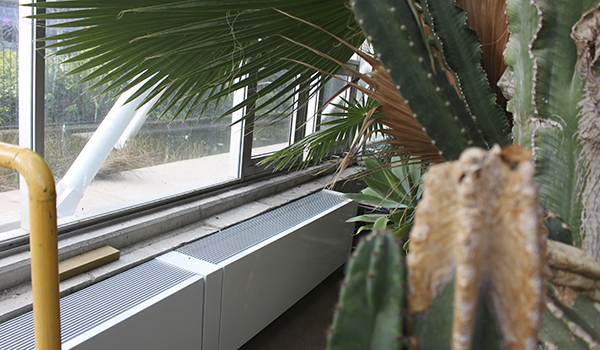Plantasia is a landmark in Swansea. Since 1990 this indoor Botanical Gardens venue has provided a fantastic destination for young and old. With over 25,000 school children visiting every year it provides a valuable educational resource for the Swansea region. Plantasia has a wide array of both exotic plants and animals who are very sensitive to their environment. Owned by the Council and operated by Parkwood Outdoors Plantasia was going to be closed because of cuts to funding but overwhelming public support guaranteed its continuation and the investment required to make its heating system fit-for-purpose. Looking to the future the operators of Plantasia want to broaden the appeal of Plantasia and attract other audiences outside normal opening times.
The Challenge
The overriding requirement of the remit for the Heating Consultant, Rob Berridge, was to ensure that a minimum of 22°C at all times. The old boilers were at least 25 years old, they continually cycled and were very expensive to run and maintain. The first challenge for Rob was to determine the heating requirements of the building. A tricky calculation made even more difficult by the fact that the whole of the space to be heated was a glass pyramid. The glass walls are 4mm thick, so the insulation is pretty ineffective. However also needing to be considered was the fact that even if the outside temperature was below freezing if the sun shone on Plantasia the solar gain was huge. Different zones representing different climatic areas required separate heating controls.
The existing heat emitters were in excessive of 25 years old and were likely installed when Plantasia was first opened in 1990. Because of the warm and humid and environment they were also showing signs of disrepair. The old emitters were made from copper pipes with aluminium fins many of which were damaged and misshapen. To add further problems to the heat output of these old emitters they were contaminated with debris which had accumulated over the years. Their efficiency was severely compromised. In total there is about 130m of wall space directly under the glass walls that is used to provide heating for the building.
The greatest challenges for the contractor, Paul Hull of The Commercia Group, were the restrictions on access to Plantasia was strictly controlled. No material could be carried through the public spaces whilst Plantasia was open to the public. To remove the old emitters and move the new Smith’s heat emitters to the installation site access was given at night whilst Plantasia was closed to the public. The old emitters were quite cumbersome to handle so care had to be taken to ensure no damage was done to the exhibits. Paul says, ‘The new emitters have compact coils in relation to the heat output being provided. They provided a highly cost effective solution with a superior life expectancy.’ A challenge was the fairly restricted space where the heat emitters were to be installed. To minimise the width of the new emitters the casing is abutted up against the heat exchangers, so this meant that the total space required is only 350mm.
Solution
Two Viessmann 200kW boilers were selected to replace the 25-year old over-specified 700kW boilers and Smith’s perimeter heating system was selected to provide the year-round minimum of 22°C. Smith’s was asked to fulfil the demanding brief for the emitters and developed a bespoke solution to meets the needs of the clients.
Simon Butcher, Senior Technical Services Manager from Smith’s, developed the bespoke solution detailed here.
Specially designed natural convection heat emitters were selected to provide the best solution. To minimise any drop in flow rate around the 130 metre system the copper flow/return pipes in the heat emitters were 28mm flowing into a header on each emitter and then into a heat exchanger of several 12mm steel pipes for excellent heat transfer. The steel fins then allow very good heat transfer.
To combat against the toxic atmosphere the Smith’s product has product casings and coils that were galvanised to ensure longevity.
The casings have damage resistant grilles that can withstand 70kg weight.
To prevent the build of debris in the fins of the heat exchangers the grilles can be removed from the casing and the heat exchanger can be washed with water from a hosepipe.
Cleaning can be done easily the grilles can be removed and the heat exchangers can be washed with water via a hosepipe. Otherwise there is no other maintenance required.
Results
Rob says that with the new boilers, and the new heat emitters there should be a reduction in the running costs of around 40% annually. The heat output from emitters is impressive and the heat haze is obvious when you look along the grilles. The heat convection can clearly be seen as it moves the leaves of the trees a couple of metres above the emitters.
The product is inconspicuous and blends into the background beneath the glazed façades and will provide gentle heat to Plantasia very efficiently for many years to come.

